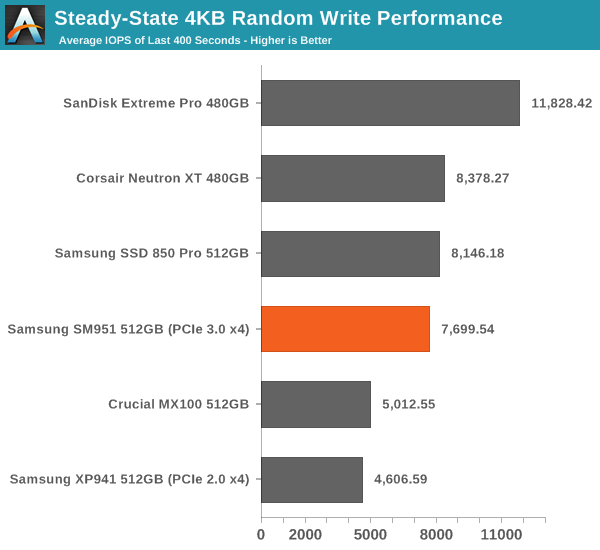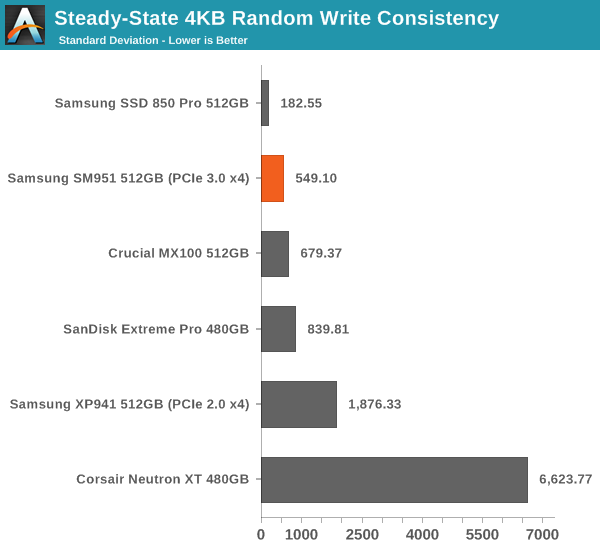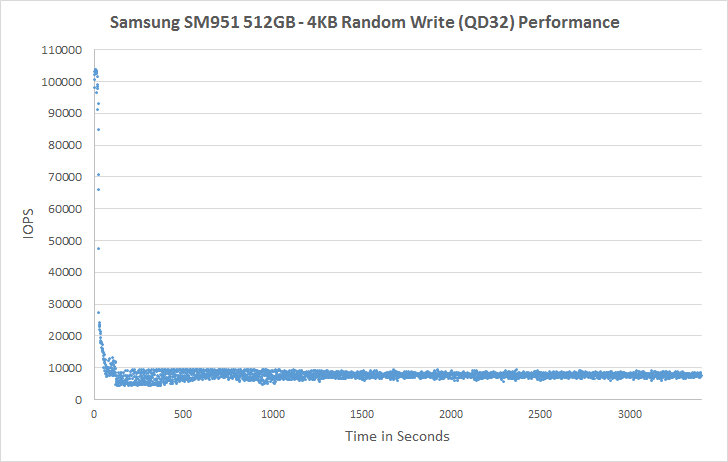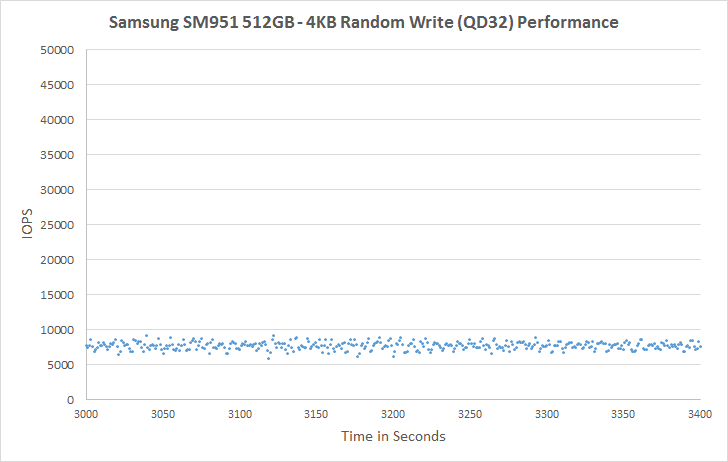Samsung SM951 (512GB) PCIe SSD Review
by Kristian Vättö on February 24, 2015 8:00 AM ESTPerformance Consistency
We've been looking at performance consistency since the Intel SSD DC S3700 review in late 2012 and it has become one of the cornerstones of our SSD reviews. Back in the days many SSD vendors were only focusing on high peak performance, which unfortunately came at the cost of sustained performance. In other words, the drives would push high IOPS in certain synthetic scenarios to provide nice marketing numbers, but as soon as you pushed the drive for more than a few minutes you could easily run into hiccups caused by poor performance consistency.
Once we started exploring IO consistency, nearly all SSD manufacturers made a move to improve consistency and for the 2015 suite, I haven't made any significant changes to the methodology we use to test IO consistency. The biggest change is the move from VDBench to Iometer 1.1.0 as the benchmarking software and I've also extended the test from 2000 seconds to a full hour to ensure that all drives hit steady-state during the test.
For better readability, I now provide bar graphs with the first one being an average IOPS of the last 400 seconds and the second graph displaying the standard deviation during the same period. Average IOPS provides a quick look into overall performance, but it can easily hide bad consistency, so looking at standard deviation is necessary for a complete look into consistency.
I'm still providing the same scatter graphs too, of course. However, I decided to dump the logarithmic graphs and go linear-only since logarithmic graphs aren't as accurate and can be hard to interpret for those who aren't familiar with them. I provide two graphs: one that includes the whole duration of the test and another that focuses on the last 400 seconds of the test to get a better scope into steady-state performance.

In steady-state performance the SM951 provides a substantial ~70% upgrade over the XP941 and brings performance nearly to the same level with the 850 Pro. Given that the 850 Pro uses faster V-NAND, the steady-state performance is a pleasant surprise and shows that the SM951 is more than a marginal bump from the XP941. Obviously, drives with more default over-provisioning (i.e. Extreme Pro and Neutron XT) provide higher steady-state performance, but Samsung is doing very well with the default 7% over-provisioning.

The consistency of the SM951 is also great. The Neutron XT is a living proof of a drive with high average IOPS, but horrible consistency because as we can see in the graph above its standard deviation is up to dozens of times higher compared to the other drives. That's just not acceptable for a modern drive, especially because there are many drives that can consistently provide high IOPS.
 |
|||||||||
| Default | |||||||||
| 25% Over-Provisioning | |||||||||
For a dozen seconds or so, the SM951 is actually able to burst out 100K IOPS, but the performance soon drops to below 10K IOPS and eventually evens out at ~7.5K IOPS. The SM951 is very consistent and doesn't experience any notable IOPS drops, whereas the XP941 regularly drops to a few hundred IOs per second. Increasing the over-provisioning to 25% brings the IOPS to about 35K, which is very decent and again much better than the XP941 that still has odd drops in performance.
 |
|||||||||
| Default | |||||||||
| 25% Over-Provisioning | |||||||||










128 Comments
View All Comments
DanNeely - Tuesday, February 24, 2015 - link
"In any case, I strongly recommend having a decent amount of airflow inside the case. My system only has two case fans (one front and one rear) and I run it with the side panels off for faster accessibility, so mine isn't an ideal setup for maximum airflow."With the space between a pair of PCIe x16 slots appearing to have become the most popular spot to put M2 slots I worry that thermal throttling might end up being worse for a lot of end user systems than on your testbench because it'll be getting broiled by GPUs. OTOH even with a GPU looming overhead, it should be possible to slap an aftermarket heatsink on using thermal tape. My parts box has a few I think would work that I've salvaged from random hardware (single wide GPUs???) over the years; if you've got anything similar lying around I'd be curious if it'd be able to fix the throttling problem.
Kristian Vättö - Tuesday, February 24, 2015 - link
I have a couple Plextor M6e Black Edition drives, which are basically M.2 adapters with an M.2 SSD and a quite massive heatsink. I currently have my hands full because of upcoming NDAs, but I can certainly try to test the SM951 with a heatsink and the case fully assembled before it starts to ship.DanNeely - Tuesday, February 24, 2015 - link
Ok, I'd definitely be interested in seeing an update when you've got the time. Thanks.Railgun - Tuesday, February 24, 2015 - link
While I can see it's a case of something is better than nothing, given the mounting options of an M.2 drive, a couple of chips will not get any direct cooling benefit. In fact, they're sitting in a space where virtually zero airflow will be happening.The Plextor solution. and any like it is all well and good, but for those that utilize a native M.2 port on any given mobo, they're kind of out of luck. As it turns out, I also have a GPU blocking just above mine for any decent sized passive cooling; 8cm at best. Maybe that's enough, but the two chips on the other side have the potential to simply cook.
DanNeely - Tuesday, February 24, 2015 - link
Depends if it's the flash chips or the ram/controller that're overheating. I think the latter two are on top and heat sinkable.jhoff80 - Tuesday, February 24, 2015 - link
It'd be even worse too for many of the mini-ITX boards that are putting the M.2 slot underneath the board.I mean, something like M.2 is ideal for these smaller cases where cabling can become an issue, so having the slot on the bottom of the board combined with a drive needing airflow sounds like grounds for a disaster.
extide - Tuesday, February 24, 2015 - link
Yeah I bet it's the controller that is being throttled, because IT is overheating, not the actual NAND chips.ZeDestructor - Tuesday, February 24, 2015 - link
I second this motion. Prefereably as a seperate article so I don't miss it (I only get to AT via RSS nowadays)rpg1966 - Tuesday, February 24, 2015 - link
Maybe a dumb question, but: the 512GB drive has 4 storage chips (two on the front, two on the back), therefore each chip stores 128GB. If the NAND chips are 64Gbit (8GB), that means there are 16 packages in each chip - is that right?Kristian Vättö - Tuesday, February 24, 2015 - link
That is correct. Samsung has been using 16-die packages for quite some time now in various products.